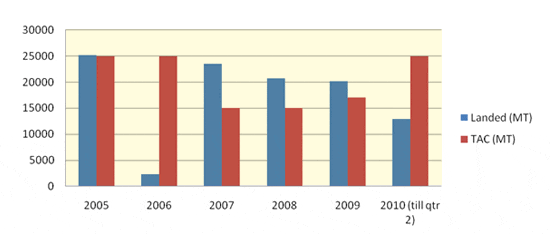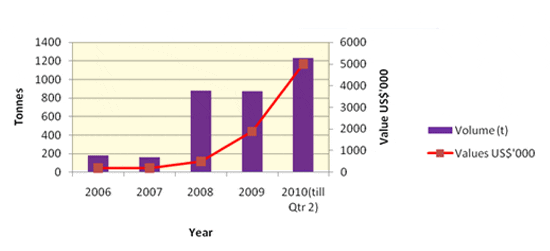The purse-seine fishery of Namibia consists largely of horse mackerel (Trachurus capensis) and pilchards (Sadinops sagax). The latter are mainly canned within Namibia and in South Africa, and are also destined for the South African and UK markets. The former are chiefly distributed to the African markets (with bulk exports to the Democratic Republic of Congo (DRC)). A significant volume of horse mackerel as well as anchovy is converted into fishmeal.
Pilchard landingsDespite a quite considerable biomass increase, the pilchard fish stock is still in a critical condition, when compared with historical levels. Hence the government has set up stringent measures and management plans for the pilchard sector, which, it is believed, will lead to the long term sustainability of the stock. This includes limiting pilchard by-catch in all other fishing industries to no more than 3% of total landings. In 2007, more than 50% of the total pilchard catch was from by-catch. The 2008 survey revealed a 55% total biomass increase when compared with 2007. The pilchard TAC for 2006 was 25 000 tonnes but dwindling stocks resulted in a reduction of 15 000 tonnes for 2007 and remained the same in 2008. In the 2009 fishing season the TAC improved slightly to 17 000 and further to 25 000 tonnes in 2010. Having recovered to some extent, the industry still remains but a fraction of the size it once was. For instance, in the early 1990s, pilchard TACs were at one time as much as four or five times the current size. It is to be noted that similar measures have been taken by the South African government with regard to pilchard catches. According to the Ministry, natural mortality remains very high for the pilchard stock as a result of predation by seals, squid, birds and other fish.
Namibian Pilchards Landings Vs. TAC

In terms of total volume landed for the past five years, Namibian horse mackerel accounts for 50 per cent to 60 per cent of the tonnage landed. Landings of horse mackerel have been decreasing from 2005 till 2008, and then picked up slightly from 2009 with total landings of 215 051 tonnes, which represent a 10 per cent increase. According to research surveys, the reduction was caused by a decline in biomass from 546 000 tonnes in 2006 to 535 000 tonnes in 2007. However, there has also been an overall reduction in the size of captured fish and this indicates that the fishery was under pressure. Furthermore, an increase in catch landed is noted for the second quarter of 2010 (70 386 tonnes) compared with 60 850 tonnes during the same period in 2009.
Namibia: Total Allowable Catch & Landings of Horse Mackerel

The main destination of horse mackerel exports is Democratic Republic of Congo (DRC) and other African countires. These are sold mainly in whole frozen, fresh or chilled form and as fishmeal.
Export value of Namibian frozen horse mackerel increased by 24% from USD 65 million in 2008 to USD 104 million in 2009. In the first quarter of 2010, horse mackerel exports were 27 797 tonnes and were valued at about USD 33 million, while in the second quarter of the same year, 25 473 tonnes were exported, valued at about USD 41 million.
Export Trends of Namibian fresh/chilled Horse Mackerel

The value of exported fresh/chilled horse mackerel increased by 73 per cent, from USD 0.5 million in 2008 to USD 2 million in 2009. During the first quarter of 2010, horse mackerel exports (885 tonnes) was valued at about USD 3 million while 357 tonnes were exported valued at USD 1 million in the second quarter.
December 2010

